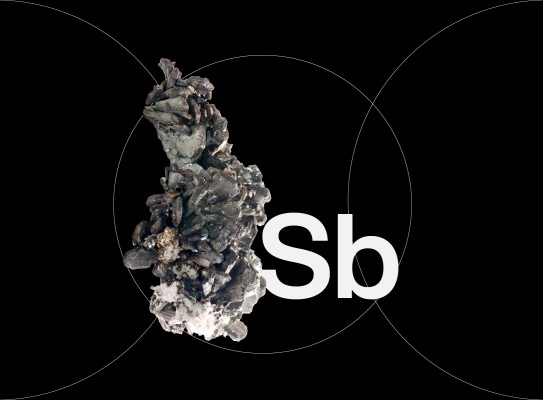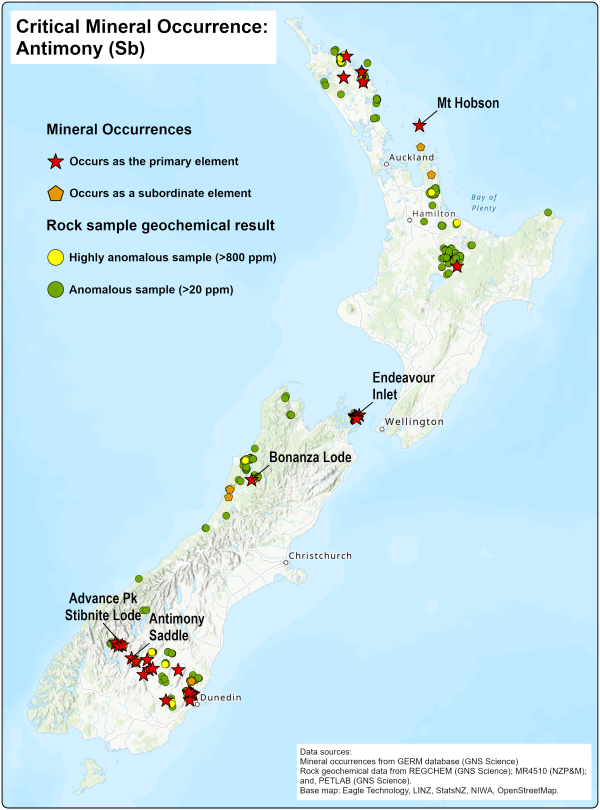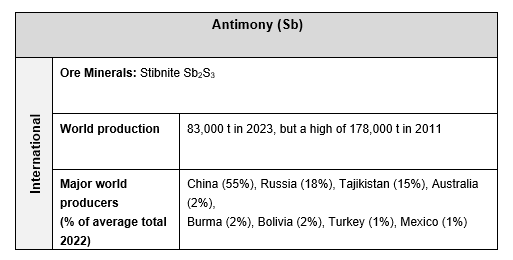Antimony

Antimony has been a prized metal for thousands of years, valued not only for its beauty but also for its unique physical and chemical properties. Its rarity, durability, malleability, and resistance to tarnish make it highly valued across various industries, from finance to advanced technology.
Antimony in New Zealand
The antimony mineral stibnite (Sb₂S₃) occurs principally in association with orogenic gold-bearing quartz veins in greywacke in Westland (Reefton) and in schist in Marlborough and Otago. Other occurrences include those in quartz veins in Mesozoic greywacke in Northland (Rangitarore Hill or Lanigan’s Mine, Waikare Inlet) and in epithermal quartz veins and sinters associated with late Cenozoic volcanism in Northland (Puhipuhi, Ngawha), Coromandel Peninsula (e.g. Te Ahumata, Mahakirau and Thames), and the Taupō Volcanic Zone.
About 3900 tonnes of antimony ore have been produced from quartz veins at Rangitarore Hill in Northland and Endeavour Inlet in Marlborough. Resources at Endeavour Inlet have been estimated at 25,000 t at 15% Sb (3750 t Sb). There is potential to produce antimony from quartz-vein deposits in the Reefton Goldfield, especially as a by-product of gold mining.

Why Antimony is Critical
- Limited Supply and Strategic Importance
Antimony is primarily produced as a by-product of gold and base metal mining, with China dominating global production. Concerns over supply chain security and geopolitical risks have prompted many countries to seek alternative sources and recycling methods. - Growing Demand for Fire Safety and Energy Storage
With increasing safety regulations and the expansion of renewable energy, the demand for flame retardants and advanced battery technologies continues to rise, making antimony a vital resource for the future.
Key uses of Antimony
-
Flame Retardants
The primary use of antimony is in antimony trioxide (ATO), a vital component in flame retardants. When combined with halogenated compounds, ATO enhances fire resistance in plastics, textiles, electrical cables, insulation materials, and consumer electronics, helping to prevent fire hazards in homes, vehicles, and workplaces.
-
Batteries and Energy Storage
Antimony is essential in lead-acid batteries, where it improves strength, corrosion resistance, and charge efficiency. These batteries are widely used in vehicles, backup power systems, and renewable energy storage. Emerging battery technologies, such as liquid metal batteries, also rely on antimony for grid-scale energy storage solutions.
-
Metallurgy and Alloys
Antimony is commonly alloyed with lead and other metals to increase hardness, strength, and wear resistance. These alloys are used in ammunition, bearings, solder, and industrial machinery. In lead-based products, such as pipes and roofing, antimony enhances durability while reducing material weight.
-
Electronics and Semiconductors
The semiconductor industry uses antimony in infrared detectors, diodes, and microelectronics. It is a key component in gallium antimonide (GaSb) and indium antimonide (InSb), materials that enable high-performance sensors, night vision systems, and advanced communication technologies.
-
Defence and Security
Due to its role in munitions, armour-piercing rounds, and fireproof materials, antimony is classified as a strategic mineral for national security. Governments worldwide consider it essential for maintaining military readiness and defence capabilities.
-
Medical and Chemical Applications
Antimony compounds are used in pharmaceuticals, particularly in treating parasitic diseases such as leishmaniasis. Additionally, it is found in catalysts, pigments, and glass manufacturing, where it improves clarity and reduces imperfections.

Additional Reading
- Christie AB, Brathwaite RL. 1993. Mineral commodity report 2: antimony. New Zealand Mining. 12:31–35.
- Price GD. 2016. The Endeavour Inlet antimony mine, Marlborough. In: Christie AB, editor. Mineral deposits of New Zealand: exploration and research. Carlton (AU): Australasian Institute of Mining and Metallurgy. p. 99–107. (Australasian Institute of Mining and Metallurgy monograph series; 31).